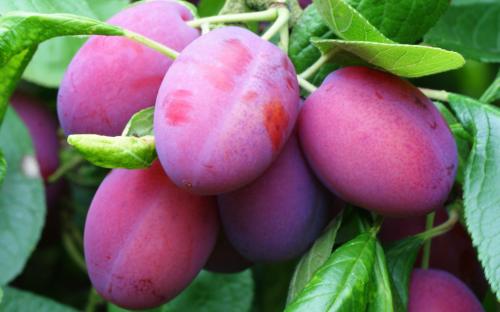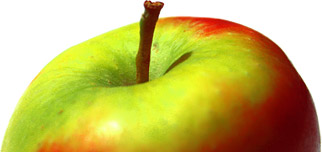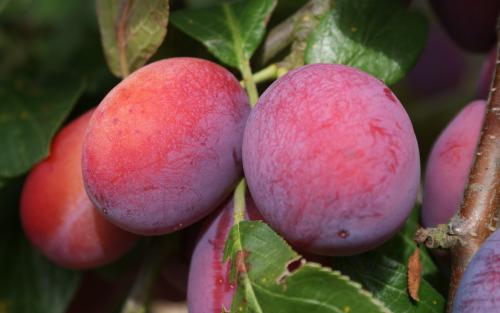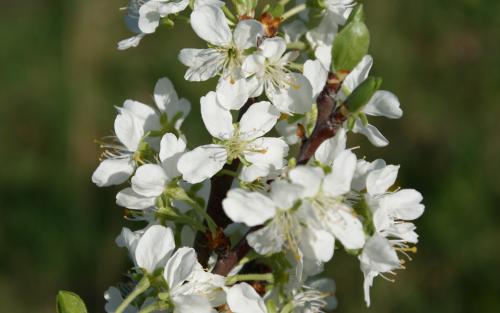
The Victoria plum is by far the most popular plum variety in the UK. It is also probably the most popular fruit tree of any species sold in UK garden centres, being self-fertile and well-known for heavy crops of very attractive fruit with a lovely red-plum colour. English gardeners wanting to grow a plum tree tend to look no further, and with good reason.
As the name suggests, Victoria dates from the Victorian era but not much is known about its origins. It was introduced in the 1840s and rapidly became a popular garden and commercial variety - a position it has maintained ever since.
Victoria really excels as a culinary plum. It cooks to a distinctive pink/orange puree which makes very good jam and a good-flavoured filling for pies and crumbles.
Victoria plums are sometimes considered inferior to other dessert plum varieties for eating fresh. However this assumption is probably based on the poor flavour of shop-bought Victoria plums, which are usually picked far too early. The trick with Victoria is to leave the plums on the tree until they are fully ripe - the skins will start to become a darker red rather than the more usual orange flushed colour. At this point the flavour, whilst not perhaps comparable with the best dessert plums, should not disappoint. (However, if you are intending to use the plums for cooking with, then it is best to pick them slightly under-ripe).
This combination of excellent culinary qualities along with pretty good flavour for eating fresh makes Victoria one of the most versatile English plum varieties. However Victoria suffers from two serious problems. Firstly it has very poor disease resistance to the plum disease silverleaf. This is a fungal disease that enters through open wounds in the bark, and for this reason Victoria plum trees, like all plum trees, should never be pruned in winter - in fact it is best to avoid pruning entirely with this variety.
Secondly, the wood is brittle, and given its tendency to over-crop, tends to result in branches breaking under the weigh of fruit - which of course are then exposed to disease infection.
Growing a Victoria plum tree is therefore a good way to gain first-hand experience of silverleaf. However whilst fruit trees that are prone to disease are often best avoided, paradoxically, Victoria is a very easy variety to grow - the inherent heavy-cropping capability means the tree tends to keep going regardless of the inevitable disease and broken branches it accumulates within a few years. It is therefore a very good choice for the gardener who wants to grow fresh plums, (although given its tendency to lose branches, perhaps not as a specimen tree).
Victoria plum identification images
All images copyright Orange Pippin unless otherwise stated.
USDA identification images for Victoria
The identification paintings in the USDA Pomological Watercolor Collection span the years 1886 to 1942.
Citation: U.S. Department of Agriculture Pomological Watercolor Collection. Rare and Special Collections, National Agricultural Library, Beltsville, MD 20705.
Offspring of this variety
Visitor reviews
- 10 May 2020 MERSEYSIDE, United KingdomI have an allotment where I am getting suckers, from the Victoria plum in the next plot, coming up in my raspberry patch. Having read the post by Adrian (2012) about the quality of suckers, I want to know whether there may be in any drawbacks to keeping a sucker in amongst the raspberries, which are in a 3x3m patch in the open. the main sucker is only about 3m from the mother tree.
- 26 Aug 2012 SUFFOLK, United KingdomWhen my mother moved into her South London house in 1956 there was a mature Victoria Plum at the bottom of her garden. It produced heavy crops all through my childhood. Eventually it succumbed to silver leaf disease and was cut down. However suckers had come up in a neighbours garden. These grew into a mature tree, we continued to eat the plums for many years hanging over the fence. This too succumbed to silver leaf, however we still eat the fruit from another suckered tree in the next garden, which still hangs over my mothers fence. This tree is not very healthy now but we have had 56 years of fruit from essentially the same tree and it was mature when we arrived!
- 08 Feb 2011 WARWICKSHIRE, United KingdomWe inherited a Victoria Plum, which was mature when we moved into our property in 1985. The tree consistently produced excellent crops of delicious plums. It contracted silver leaf disease and significant die back and had to be taken down a couple of years ago. It produced fruit for at least 40 years and I thoroughly recommend it.
Tree register
United States
- Jessica Klein in Maple Valley, WASHINGTON
- Karen in Oakland, CA
- Rex Callis in Pittsboro, IN
United Kingdom
- Reach Community Orchard in Cambridge,
- Reach Community Orchard in Cambridge,
- Ak in Macclesfield, ENGLAND
- Alan Elsbury in Chippenham, WILTSHIRE
- Alex in Scourie, SUTHERLAND
- Alison Quinsey in Beccles, SUFFOLK
- Alison Underwood in Colwyn Bay, NORTH WALES
- Andrew in BELFAST, ANTRIM
- Andrew Shields in Alnwick, NORTHUMBERLAND
- Andy in Surrey,
- Angela in Alsager, CHESHIRE
- Angela Beech in Peterborough, CAMBRIDGESHIRE
- Angela Bogle in Bakewell, DERBYSHIRE
- Anja Britton in NOTTINGHAMSHIRE
- Ann Davis in Sutton, MACCLESFIELD
- Annette Hurt in Filby, NORFOLK
- Bob Henley in Winchester, HAMPSHIRE
- Brian Heaney in Newcastle Upon Tyne, TYNE AND WEAR
- Brian Sharp in Burrelton, PERTHSHIRE
- Bruce Nottrodt in Taunton, SOMERSET
- C. J. Barnes in Norton Subcourse, NORFOLK
- Carol in Lincoln, LINCS
- Catherine Jeffery in Horning, NORFOLK
- Charles Wills in GUNNISLAKE, CORNWALL
- Charlotte Chapman in PETERBOROUGH, CAMBRIDGESHIRE
- Christine Woolass in Goole, YORKSHIRE
- Christopher in Sleaford, LINCS
- Claire in LANCASTER, LANCASHIRE
- Colin Bowen in London,
- Colin P Dolding in Hanley Castle, WORCESTERSHIRE
- Conrad Maloney in CHELTENHAM, GLOUCESTERSHIRE
- Craig Lawrence in Wakefield,
- Dan in Uxbridge, MIDDLESEX
- Daniel Mills in FISKERTON, LINCS
- Dave Hoare in Harefield, MIDDLESEX
- David Harmston in Ewerby Thorpe, Sleaford, LINCS
- David Porter in POOLE, DORSET
- David Scholes in Saddleworth,
- David Stuart in Gateshead, TYNE AND WEAR
- David Styles in Hove, EAST SUSSEX
- Davidjohndawkins in Ely, CAMBS
- Deborah Kaufmann in Hyde,
- Deborah Kaufmann in Mossley,
- Derek Turnbull in Chesterfield, DERBYSHIRE
- Diana Barnes in Heywood, LANCASHIRE
- Diana Gibbs in LOWER RAYDON,
- Dianne Trembath in Newport, SHROPSHIRE
- Donna Gillies in Ardgay, HIGHLAND
- Edward Evans in MANNINGTREE, SUFFOLK
- Eileen Brown in Blairgowrie, PERTH AND KINROSS
- Elaine Evans in Mold, FLINTSHIRE
- Elaine Evans in Mold, FLINTSHIRE
- Elaine Evans in Mold, FLINTSHIRE
- Esiah in London, SURREY
- Gill Theobald in IVYBRIDGE, DEVON
- Graeme Stockdale in Pilsley, Chesterfield, DERBYSHIRE
- Graham Hatch in Blackburn, LANCASHIRE
- Graham Herridge in Biggleswade, BEDS
- Graham Tibble in Southampton, HAMPSHIRE
- Graham Tibble in Southampton, HAMPSHIRE
- Hazel Chipchase in Cheadle Hulme, CHESHIRE
- Helen Kershaw in Liverpool, MERSEYSIDE
- Helen Pennington in Royston,
- Henryc in Andover, HAMPSHIRE
- Howard Green in Whitby, NORTH YORKSHIRE
- Hugh Morton in Kingsbridge, DEVON
- Jacqueline Lawrence in Milford Haven, PEMBROKESHIRE
- James in Melbourne, DERBYSHIRE
- James Bartlett in Oakham, RUTLAND
- James Kidd in Hightae, DUMFRIES AND GALLOWAY
- James Kidd in Hightae, DUMFRIES AND GALLOWAY
- Jane Cannig in Evesham,, WORCESTERSHIRE.
- Jane Durney in Polzeath, CORNWALL
- Jane f in Boxford, SUFFOLK
- Janet in St Austell, CORNWALL
- Janet Chetwood in Sedbergh, CUMBRIA
- Jean Lippett in Martock, SOMERSET
- Jeff in Leicester, LEICESTERSHIRE
- Jen in Whitley Bay, TYNE AND WEAR
- John Coggin in Walton Le Dale, LANCS
- John Halliday in Congleton, CHESHIRE
- John Leitch in Ayr, AYRSHIRE
- Joy in Bristol, BRISTOL
- Joy Lucas in Saddleworth, LANCASHIRE
- jrwyllie in Haddington, EAST LOTHIAN
- Julian Smith in Radcliffe-On-Trent, NOTTINGHAMSHIRE
- Ken Shutt in Romford, ESSEX
- Kevin Chadwick in Birmingham, WEST MIDLANDS
- Kirsten Edwards in WAKEFIELD, COUNTY
- Kurt Bruendel in Windsor, BERKSHIRE
- Kyle Oram in LANCASTER, LANCASHIRE
- Laurence Streatfield in Hayle, CORNWALL
- Les Brear in Todmorden, WEST YORKSHIRE
- Lesley Blair in Glasgow,
- Leslie Dickinson in Edinburgh, MIDLOTHIAN
- Linda Robinson in Darlington, DURHAM
- Lol Peacock in Nottingham, NOTTINGHAMSHIRE
- Lucy Newbury in Melksham, WILTSHIRE
- margaret in Stonehaven,
- Margaret Parsons in Hull, EAST YORKSHIRE
- Mark Davies in Saddleworth, YORKSHIRE
- Mary Fielding in LEDBURY, HEREFORDSHIRE
- Matt Brown in Chester, CHESHIRE
- Michael Abbott in Glasgow, LANARKSHIRE
- Michael Adams in Halifax, WEST YORKSHIRE
- Michael Adams in Halifax, WEST YORKSHIRE
- Mrs Cherry Steel in Bingley, WEST YORKSHIRE
- Mrs Sophie Wiles in Flamborough, EAST YORKSHIRE
- Mrs Stephanie Bond in Stourton Caundle, DORSET
- N. Buck in Cambridge, CAMBRIDGESHIRE
- Natasha Surridge in Rustington, WEST SUSSEX
- Nathalie Mills-Oaka in London, LONDON
- Neil Harris in Knowle, WEST MIDLANDS
- Nick Butcher in North Curry, SOMERSET
- Nickkk in Oldham, LANCASHIRE
- Nicola Kirkpatrick in Howden, EAST YORKSHIRE
- Nigel in Ryton Dorrington Shrewsbury, SHROPSHIRE
- Paddy in WIMBLEDON, UK
- Pamela in Bressingham, NORFOLK
- Paul Knight in Eastleigh, HAMPSHIRE
- Paul Mckean in Southport, MERSEYSIDE
- Peter Kent in Casnewydd, GWENT
- Peter Radmore in Port Talbot, SOUTH WALES UK
- Peter Tyler in Eye, SUFFOLK
- Peter Willis in Peterborough, CAMBS
- Phillip Orion in Eastington, GLOUCESTERSHIRE
- Raymond Green in Kingussie, INVERNESS-SHIRE, SCOTLAND
- Richard Ayling in Swansea,
- Richard Ayling in Swansea,
- Richard Borrie in York, YORKSHIRE
- Sally Turley in London, LONDON
- Sedgie in Saltburn By The Sea, NORTH YORKSHIRE
- Shane Emmerson in WARWICKSHIRE
- Simon Bourne in Edenbridge, KENT
- stanwatt2008@hotmail.co.uk in Gardenstown, ABERDEENSHIRE
- Sue Fawcett in Pocklington, York, YORKSHIRE
- Tamas Geleta in UCKFIELD,
- Tony in Glasgow, SCOTLAND
- Tony in Glasgow, SCOTLAND
- Tony Serjeant in Taunton, SOMERSET
- Tracey Doman in Carey, HEREFORDSHIRE
- Trudy Prynne in READING
- Valerie Bhattacharjee in Wool, Wareham, DORSET
- Victoria Birkett in Aberdeen, SCOTLAND
- Vincent Bentley in Montgomery, POWYS
- Wayne Seagate in Watlington, NORFOLK
- Zoe Mitchell in Milton Keynes, UNITED KINGDOM
Denmark
- Bent Ransborg in Langaa, JYLLAND
France
- Paul Kendall in Poupas, TARN-ET-GARONNE
- Richard Borrie in Objat,
Ireland
- James A Nolan in Glynn, WEXFORD
- James Munro in Westport, COUNTY MAYO
- Maurico Pipistrello in Shanaglish, Gort, CO GALWAY
- Nikolai in Dublin, DUBLIN
- Sean Cremin in NEWCASTLE WEST,
- Simon Clarke in Duleek, COUNTY MEATH
Australia
- Neville in Tea Tree Gully, SA
Poland
- Richard in Krakow,
Spring blossom records for this variety
2025 season
- 1st April 2025 - tree owned by Wayne in Watlington, United Kingdom
- April 2025 - tree owned by John in Congleton, United Kingdom
- 10th March 2025 - tree owned by James in Westport, Ireland
2024 season
- 12th March 2024 - tree owned by James in Westport, Ireland
2022 season
- 15th April 2022 - tree owned by James in Glynn, Ireland
- 2nd April 2022 - tree owned by Paul in Southport, United Kingdom
- 27th March 2022 - tree owned by Richard in Objat, France
- 16th March 2022 - tree owned by James in Westport, Ireland
2021 season
- 8th April 2021 - tree owned by James in Melbourne, United Kingdom
2020 season
- 10th April 2020 - tree owned by James in Glynn, Ireland
2018 season
- 20th April 2018 - tree owned by David in Hove, United Kingdom
- 15th April 2018 - tree owned by Paul in Southport, United Kingdom
- 7th April 2018 - tree owned by Andrew in BELFAST, United Kingdom
2017 season
- 3rd October 2017 - tree owned by Neville in Tea Tree Gully, Australia
- 10th April 2017 - tree owned by Hugh in Kingsbridge, United Kingdom
- 28th March 2017 - tree owned by Ken in Romford, United Kingdom
2016 season
- 8th October 2016 - tree owned by Neville in Tea Tree Gully, Australia
- 13th April 2016 - tree owned by Paul in Southport, United Kingdom
2015 season
- 23rd September 2015 - tree owned by Neville in Tea Tree Gully, Australia
- 21st April 2015 - tree owned by Paul in Southport, United Kingdom
2014 season
- 19th June 2014 - tree owned by Nicola in Howden, United Kingdom
- May 2014 - tree owned by Paul in Southport, United Kingdom
- 24th April 2014 - tree owned by Neil in Knowle, United Kingdom
- 12th April 2014 - tree owned by Bruce in Taunton, United Kingdom
- 2nd April 2014 - tree owned by Zoe in Milton Keynes, United Kingdom
- 13th March 2014 - tree owned by Esiah in London, United Kingdom
2013 season
- 8th May 2013 - tree owned by Graham in Blackburn, United Kingdom
- 6th May 2013 - tree owned by Paul in Southport, United Kingdom
- 1st May 2013 - tree owned by Richard in York, United Kingdom
- May 2013 - tree owned by stanwatt2008@hotmail.co.uk in Gardenstown, United Kingdom
- 25th April 2013 - tree owned by David in Ewerby Thorpe, Sleaford, United Kingdom
- April 2013 - tree owned by John in Congleton, United Kingdom
- March 2013 - tree owned by John in Ayr, United Kingdom
2012 season
- 18th April 2012 - tree owned by Nickkk in Oldham, United Kingdom
- 18th April 2012 - tree owned by stanwatt2008@hotmail.co.uk in Gardenstown, United Kingdom
- 7th April 2012 - tree owned by Peter in Peterborough, United Kingdom
- 5th April 2012 - tree owned by Alan in Chippenham, United Kingdom
- 4th April 2012 - tree owned by Bruce in Taunton, United Kingdom
- 28th March 2012 - tree owned by Simon in Duleek, Ireland
- 24th March 2012 - tree owned by David in Gateshead, United Kingdom
2011 season
- 9th April 2011 - tree owned by Peter in Peterborough, United Kingdom
- 6th April 2011 - tree owned by Richard in York, United Kingdom
- 5th April 2011 - tree owned by Simon in Duleek, Ireland
- 4th April 2011 - tree owned by David in Ewerby Thorpe, Sleaford, United Kingdom
- 4th April 2011 - tree owned by James in Melbourne, United Kingdom
- 1st April 2011 - tree owned by Alan in Chippenham, United Kingdom
2010 season
- 18th April 2010 - tree owned by N. in Cambridge, United Kingdom
- 1st April 2010 - tree owned by Nikolai in Dublin, Ireland
2009 season
- 3rd April 2009 - tree owned by N. in Cambridge, United Kingdom
Record your blossom dates in our Fruit Tree Register - more >>.
Harvest records for this variety
2025 season
- 2nd week August 2025 - tree owned by John in Congleton, United Kingdom
- 1st week August 2025 - tree owned by James in Melbourne, United Kingdom
2022 season
- 1st week August 2022 - tree owned by Paul in Southport, United Kingdom
2018 season
- 3rd week August 2018 - tree owned by Andrew in BELFAST, United Kingdom
2017 season
- 3rd week August 2017 - tree owned by John in Congleton, United Kingdom
- 3rd week August 2017 - tree owned by Ken in Romford, United Kingdom
2016 season
- 1st week September 2016 - tree owned by Ken in Romford, United Kingdom
- September 2016 - tree owned by Elaine in Mold, United Kingdom
- September 2016 - tree owned by Elaine in Mold, United Kingdom
- September 2016 - tree owned by Elaine in Mold, United Kingdom
- 4th week August 2016 - tree owned by Hugh in Kingsbridge, United Kingdom
2015 season
- 2nd week August 2015 - tree owned by Leslie in Edinburgh, United Kingdom
- August 2015 - tree owned by Paul in Southport, United Kingdom
2014 season
- 4th week September 2014 - tree owned by Esiah in London, United Kingdom
- September 2014 - tree owned by Paul in Southport, United Kingdom
2013 season
- 3rd week September 2013 - tree owned by John in Congleton, United Kingdom
- 3rd week September 2013 - tree owned by Richard in York, United Kingdom
- 2nd week September 2013 - tree owned by Paul in Southport, United Kingdom
- 3rd week August 2013 - tree owned by John in Ayr, United Kingdom
2012 season
- 1st week September 2012 - tree owned by Zoe in Milton Keynes, United Kingdom
- 1st week September 2012 - tree owned by Richard in York, United Kingdom
- September 2012 - tree owned by Janet in St Austell, United Kingdom
- September 2012 - tree owned by Janet in St Austell, United Kingdom
- 3rd week July 2012 - tree owned by Kurt in Windsor, United Kingdom
2011 season
- 1st week September 2011 - tree owned by Mark in Saddleworth, United Kingdom
- 3rd week August 2011 - tree owned by Simon in Duleek, Ireland
- 3rd week August 2011 - tree owned by Peter in Peterborough, United Kingdom
- 2nd week August 2011 - tree owned by James in Melbourne, United Kingdom
2010 season
- 3rd week August 2010 - tree owned by Nikolai in Dublin, Ireland
- 2nd week August 2010 - tree owned by Dianne in Newport, United Kingdom
2009 season
Origins
- Species: Prunus domestica - European plum
- Originates from: Alderton, Sussex, United Kingdom
- Introduced: 1840s
Identification
- Awards: RHS AGM (current)
- Country of origin: United Kingdom
- Period of origin: 1800 - 1849
- Fruit colour: Red
- Flower colour: White
- Leaf colour: Green
- Popularity: Best sellers
- Annual cycle: Deciduous
Using
- Cling-stone: Freestone
- Picking season: Mid
- Keeping (of fruit): 1 week
- Flavour quality: Exceptional
- Cropping: Heavy
- Fruit persistence: Ripens over a period
- Food uses: Eating fresh
- Food uses: Culinary
- Food uses: Dual purpose
- Picking period: mid-August
- Wildlife: RHS Plants for Pollinators
Growing
- Gardening skill: Beginner
- Flowering group: 3
- Pollinating others: Good
- Vigour: Slightly large
- Bearing regularity: Regular
- Organic culture: Suitable
- Attractive features: Attractive fruit
- Self-fertility: Self-fertile
Climate
- Frost resistance of blossom: Good resistance
- Climate suitability: Temperate climates
- Summer average maximum temperatures: Cool ( 20-24C / 68-75F)
- Summer average maximum temperatures: Warm (25-30C / 76-85F)
- Cold hardiness (RHS): H5 (to -15C)
- Summer average maximum temperatures: Cold (< 20C / 67F)
Other qualities
- Disease resistance: Poor
- Plum pox virus / Sharka: Some susceptibility
- Silverleaf: Very susceptible
Where to buy trees
The following tree nurseries offer Victoria plum trees for sale:
- Orange Pippin Fruit Trees (USA) United States
Victoria plum trees - Orange Pippin Fruit Trees (UK) United Kingdom
Victoria plum trees - Thomas Fruit Trees (EU) France
Victoria plum trees
Where to buy fresh fruit
The following orchards grow Victoria:
United Kingdom
England - midlands
- Walsgrove Farm, Worcester
England - north
- Lockwood Hey Orchard, Saddleworth
- Saddleworth Orchard, Saddleworth
England - south-east
- Home Cottage Farm, Iver
- Wigmore Orchard, Tadley
- Holton Orchards, Halesworth
England - south-west
- A'Beckett's, Devizes
References
- Fruit Expert
Author: Hessayon



